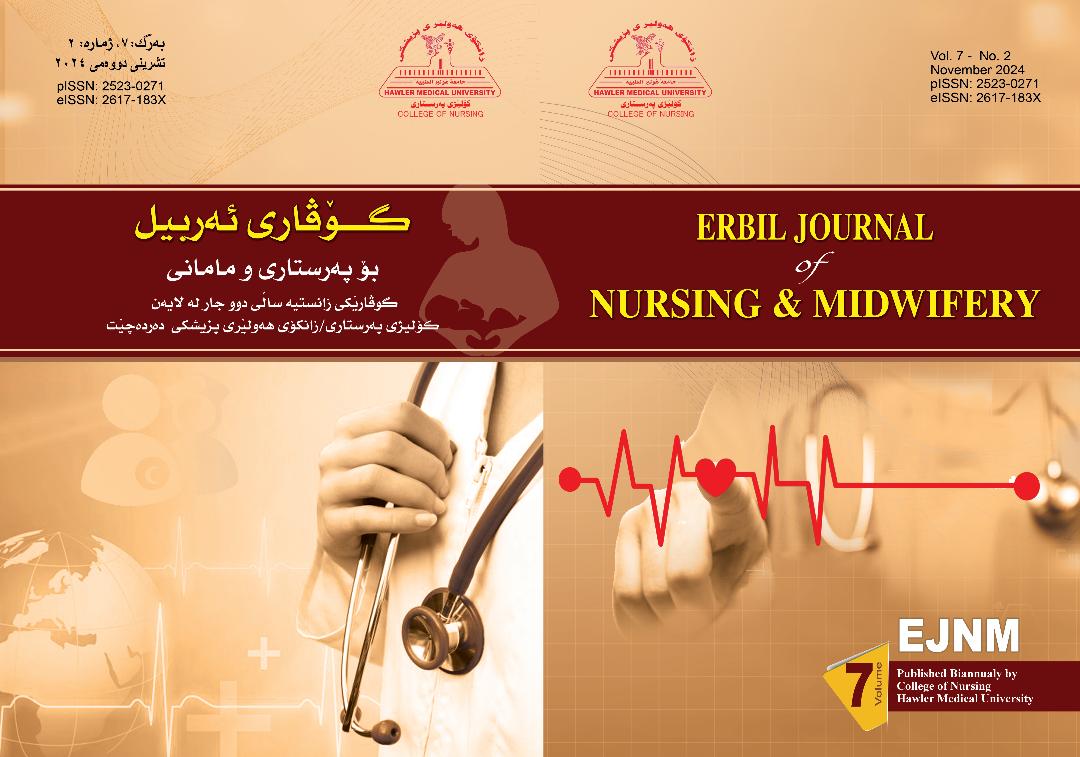Impact of an Educational Program on Quality of Life among Patients Undergoing Hemodialysis in Akre/ Iraqi Kurdistan Region
DOI:
https://doi.org/10.15218/ejnm.2024.20Keywords:
End-stage renal disease, Hemodialysis, Educational program, Quality of LifeAbstract
Background and Objective: Chronic kidney diseases is an international public health issue, and it has a rising extent, occurrence and significant treatment expenditures. The guidance is a crucial step in raising the standard of dialysis care and improving the results of quality of life for end- stage renal disease patients. Therefore, the study's objectives were to establish, implement, and evaluate the impact of the educational program on hemodialysis patients' quality of life at the study site.
Methods: A quasi-experimental research study was conducted at the Urology Center's hemodialysis units at Golan General Hospital in Akre. Data were collected from 30 adult dialysis patients who were undergoing dialysis regularly.
Results: According to the current study, patients' overall mean quality of life scores increased in many aspects of quality of life (physical, psychological and social) with a statistically significant difference shortly after the program's introduction. This increased level was marginally reduced after a month of program implementation.
Conclusion: The overall quality of life of the patients who underwent the intervention saw an improvement in score, all metrics relating to quality of life and health were significantly improved by the educational program.
Metrics
References
(1) K. Landreneau, K. Lee, and M. D. Landreneau, “Quality of life in patients undergoing hemodialysis and renal transplantation meta-analytic review,” Nephrol. Nurs. J., vol. 37, no. 1, p. 37, 2010.
(2) 2E. Nemati and M. Motalebi, “A Better Quality of Life in Hemodialysis Patients With Viral Hepatitis: Is it a Reality?,” Hepat. Mon., vol. 13, no. 11, 2013.
(3) Z. Wen et al., “Health related quality of life in patients with chronic gastritis and peptic ulcer and factors with impact: a longitudinal study,” BMC Gastroenterol., vol. 14, pp. 1–10, 2014.
(4) A. H. A. Mazairac et al., “Differences in quality of life of hemodialysis patients between dialysis centers,” Qual. life Res., vol. 21, pp. 299–307, 2012.
(5) S. W. Klarenbach, M. Tonelli, B. Chui, and B. J. Manns, “Economic evaluation of dialysis therapies,” Nat. Rev. Nephrol., vol. 10, no. 11, pp. 644–652, 2014.
(6) A. H. Pakpour, I. M. Zeidi, N. Chatzisarantis, S. Molsted, A. P. Harrison, and R. C. Plotnikoff, “Effects of action planning and coping planning within the theory of planned be-haviour: A physical activity study of patients undergoing haemodialysis,” Psychol. Sport Exerc., vol. 12, no. 6, pp. 609–614, 2011.
(7) Y. Lii, S. Tsay, and T. Wang, “Group intervention to improve quality of life in haemodialysis patients,” J. Clin. Nurs., vol. 16, no. 11c, pp. 268–275, 2007.
(8) D. L. Mapes et al., “Health-related quality of life as a predictor of mortality and hospitalization: the Dialysis Outcomes and Practice Patterns Study (DOPPS),” Kidney Int., vol. 64, no. 1, pp. 339–349, 2003.
(9) F. Yang et al., “Health-related quality of life of Asian patients with end-stage renal disease (ESRD) in Singapore,” Qual. Life Res., vol. 24, pp. 2163–2171, 2015.
(10) S. M. Skevington, M. Lotfy, and K. A. O’Con-nell, “The World Health Organization’s WHOQOL-BREF quality of life assessment: psychometric properties and results of the international field trial. A report from the WHOQOL group,” Qual. life Res., vol. 13, pp. 299–310, 2004.
(11) M. K. Jahromi, S. Javadpour, L. Taheri, and F. Poorgholami, “Effect of nurse-led telephone follow ups (tele-nursing) on depression, anxiety and stress in hemodialysis patients,” Glob. J. Health Sci., vol. 8, no. 3, p. 168, 2016.
(12) C. Bale et al., “Psychosocial factors in end-stage kidney disease patients at a tertiary hospital in Australia,” Int. J. Nephrol., vol. 2016, 2016.
(13) M. A. Bakarman, M. K. Felimban, M. M. Atta, and N. S. Butt, “The effect of an educational program on quality of life in patients under-going hemodialysis in western Saudi Arabia,” Saudi Med. J., vol. 40, no. 1, p. 66, 2019.
(14) M. S. Ghadam, F. Poorgholami, Z. B. Jahromi, N. Parandavar, N. Kalani, and E. Rahmanian, “Effect of self-care education by face-to-face method on the quality of life in hemodialysis patients (relying on Ferrans and Powers Questionnaire),” Glob. J. Health Sci., vol. 8, no. 6, p. 121, 2016.
(15) S. Abraham, A. Venu, A. Ramachandran, P. M. Chandran, and S. Raman, “Assessment of quality of life in patients on hemodialysis and the impact of counseling,” Saudi J. Kidney Dis. Transplant., vol. 23, no. 5, pp. 953–957, 2012.
(16) I. S. Salam and M. A. Abdelhady, “Impact of teaching guidelines on quality of life for hemodialysis patients,” Nature and Science,vol. 8 , no. 9, p. 219, 2011.
(17) M. Bayoumi, A. Al Harbi, A. Al Suwaida, M. Al Ghonaim, J. Al Wakeel, and A. Mishkiry, “Predictors of quality of life in hemodialysis patients,” Saudi J. Kidney Dis. Transplant., vol. 24, no. 2, pp. 254– 259, 2013.
(18) A. Seica et al., “Factors affecting the quality of life of haemodialysis patients from Romania: a multicentric study,” Nephrol. Dial. Transplant., vol. 24, no. 2, pp. 626–629, 2009.
(19) A. Alshraifeen, M. McCreaddie, and J. M. M. Evans, “Quality of life and well‐being of people receiving haemodialysis treatment in Scotland: A cross‐sectional survey,” Int. J. Nurs. Pract., vol. 20, no. 5, pp. 518–523, 2014.
(20) B. S. Sathvik, G. Parthasarathi, M. G. Nara-hari, and K. C. Gurudev, “An assessment of the quality of life in hemodialysis patients using the WHOQOL-BREF questionnaire,” Indian J. Nephrol., vol. 18, no. 4, p. 141, 2008.
Downloads
Published
How to Cite
Issue
Section
License
Copyright (c) 2024 Zikri Mahmood Mirza (Author)

This work is licensed under a Creative Commons Attribution-NonCommercial-ShareAlike 4.0 International License.



















